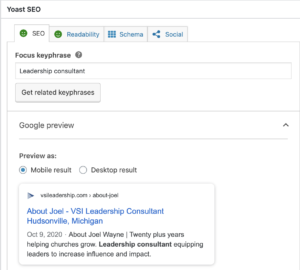There’s a lot of talk about keywords today and how they affect SEO (search engine optimization). For business leaders, it may seem overwhelming or simply the last thing you or your staff has time for in the daily task list. But getting web copy (text) is important to attract a growing number of targeted customers. You want keywords to be recognized by search engines through strategic placement. So, here’s a quick process to making keywords work for you.
How to Optimize Using Keywords
1. Select Targeted Keywords
Select keywords that are relevant to your businesses. Ask yourself or your client what people will be searching for that will lead them to your company. These are your keywords. Put the list into a Google or Excel sheet. Use these words in your web copy, images, social media, and external directories, as I’ll explain further below.
2. Conduct On-page SEO
There are important places to use your keywords for SEO. Start with each page of your website. This is called on-page SEO. Using the Yoast plugin or Semrush Content Template Tool are great guides and timesavers.
Page Titles
Page title optimization is a good starting point for on-page SEO. A page title describes your page’s primary subject and shows up as the first line on search engine results pages (SERPs). This lets Google and searchers know what the page is about. Below is what Yoast looks like on a website backend, making sure all your SEO details are in check.
Meta Descriptions
Meta descriptions are the next important area for using keywords in SEO and show up as the second part of a search results entry in SERPs. Meta descriptions help Google determine how relevant your content is and helps searchers decide whether to click through from a search result to your website. These descriptions do not show up on your page, but using a tool like Yoast will guide you in optimizing meta descriptions.
Subheadings
Subheadings are found within your main content and may also appear as part of a featured snippet or answer box. This is another great place to add keywords.
General Content
Optimize the use of these words in your content, but avoid over-stuffing. If your readers won’t like it, Google won’t like it either. Use your main keyword in the first couple of sentences in your content, or at least in the first paragraph. Then use a variation of it throughout the content. Write for humans (not Google) and make the content readable and understandable.
Title of Images
Images are indexed, too, creating another way for people to find your content. So, use keywords in image titles.
Alt Text in Images
Use keywords in alt text for your images. Alt text helps with accessibility for those with disabilities. Make the text descriptive using more than just keywords.
URLs
URLs give Google an indicator about what’s on the page. Use no more than one or two keywords in the URL to make sense to those visiting your site.
Link Anchor Text
Link anchor text is the clickable text highlighted as a link. Vary it up so that you don’t use the same anchor text for every link you create. This applies to both internal and external links.
3. Use Keywords in Social Media
Use keywords in social media updates for better SEO and keep them early in the update to be immediately visible. They are also helpful as hashtags in social media updates. Pay attention to how you use keywords as hashtags since hashtag use varies from platform to platform. Consider using keyword hashtags in your bio on Twitter and Instagram and your Facebook page’s category and description.
4. Use Keywords in Directories and External Listings
When setting up external business listings like Google My Business, be sure to include keywords in your business description.
Start With Intent
If you aren’t sure where to start with SEO, keywords are a great place. Remember to start by putting yourself in your audience’s shoes. What is your target audience asking when searching for a business like yours? Figure out what they are searching for and build your content around those words. Let me know if you need help getting started.






